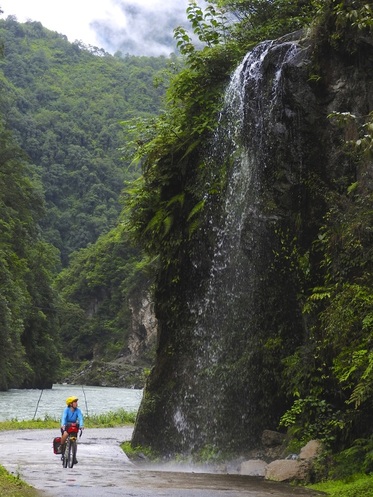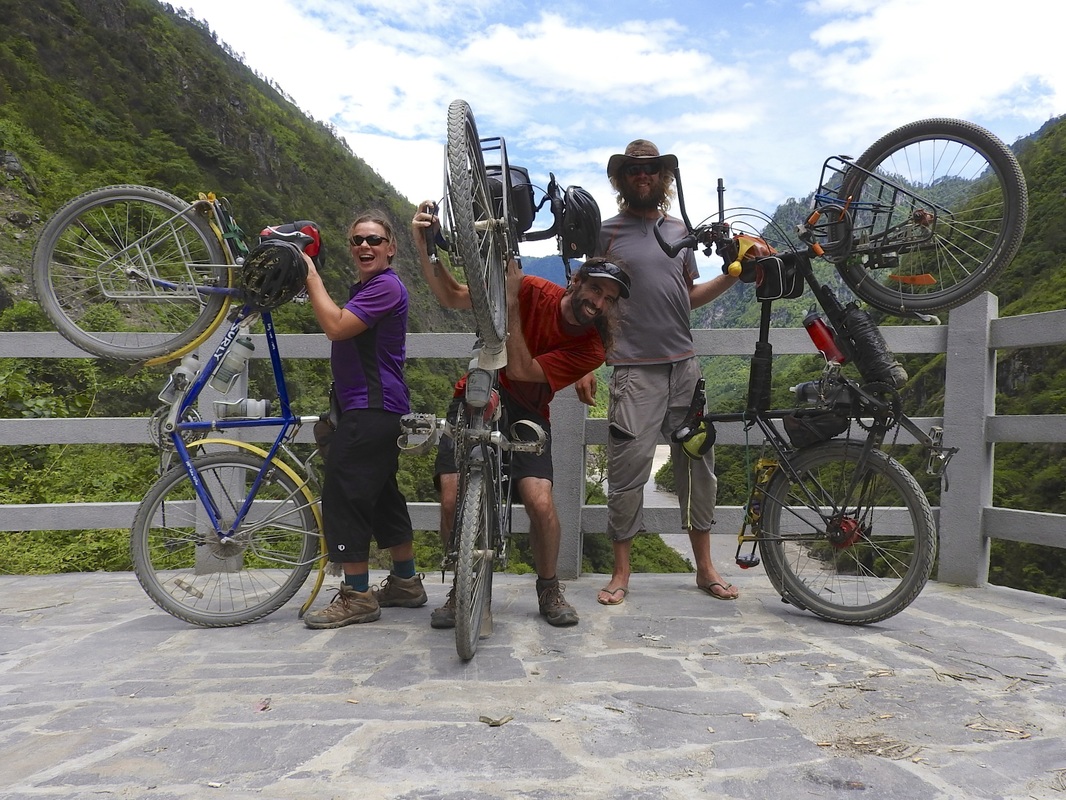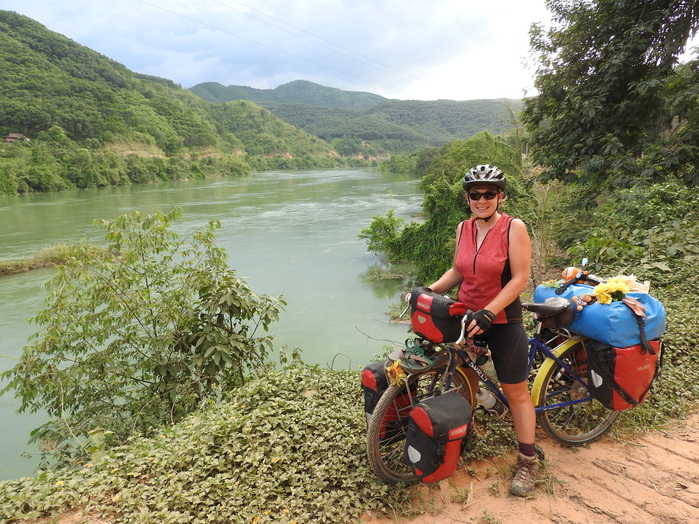
On the upside, we didn't mind having a good excuse to skip over two days of backtracking to Liuku and readied our bikes and bags to hitch a ride in a truck. Despite being conveniently located next to a routine traffic police checkpoint with the vehicles already stopped, all we got were rejections. I looked up the world's for "broken", "help", and "hitchhike" in our Mandarin phrase book and approached the policeman on duty for assistance. He caught on, except for the hitchhike part, and directed a shared minivan taxi to pick us up. Lashing the bikes to the roof on top of each other was not as damaging as we had imagined, nor was the "efficient" (translation: scary crazy) journey back to Liuku as expensive as we had dreaded. We were also surprised to recognize one of the passengers as a Dulong woman we had partied with in Bapo!
In Liuku, we begrudgingly reunited with the rest of our belongings, but still refused to get rid of any of them. It seems that our obsessions with self-sufficiency, worst-case scenario preparedness, frugality, and not planning the future combine forces to make us overly attached to the ridiculous contents of our panniers. Examples range from scuba dive masks that were once useful in Thailand to thick gloves we bought for trekking in Nepal, but maybe we will go back to the ocean, or maybe we will find winter somewhere again, so...let's just repack them!
From Liuku, we took an all-day bus ride to Kunming, "city of eternal spring", so the saying goes regarding its perfect climate. The first order of business was beginning the frustratingly bureaucratic process of getting ridiculously expensive visas for Vietnam. We will spare you the details, but basically it involved getting three different answers from three different staff each time we asked the same question. The second order of business was heading to Pegasus Cycling, a recommended bike shop with a charismatic owner, Hui Li, who passionate about cycle touring. Also a popular Warm Showers host, we admired Hui's photo display of bicycle travelers who've spent the night in his shop over the last few years.
After two new wheels were built for Matt's bike, we joined Hui on a weekend ride with his cycling club. Sometimes we feel a little self-conscious about how we dress as cycletourers since we sport more "formal" gear than most. However, with the Chinese cyclists gathering in front of Pegasus that Saturday morning, we fit right in with our helmets, gloves, spandex shorts, and cycle jerseys. In fact, we were the ones that looked laid back in comparison to their full body spandex and sun-shielding face masks. Somehow we navigated through Kunming's traffic and out into the 'burbs under development as a loose peloton of about twenty. The 50-mile ride was not always the most scenic or enjoyable with a decent amount of truck traffic, but the destination of Fuxian Lake was unquestionably a worthwhile reward.
As a popular weekend getaway for Kunmingers, the lake is lined with beachside restaurants. We took over one of them and spent the afternoon swimming in the refreshing clear water and continuing to socialize with the welcoming and friendly cycle club members. Dinner was a feast of family style dishes interrupted by many toasts of a strong corn-based liquor from a flask so big it required two hands to pour. As hungry cyclists, we did a better than average job of finishing the copious quantities of food typical of Chinese dining. That night we created a tightly-packed tent city amongst parked vehicles in a field next to the restaurant. Our extra-large Hilleberg tent drew a lot of attention and many folks came over just to poke their head inside.
The next day was just like the first day, but in reverse. After munching some watermelon and saying our goodbyes back at Pegasus Cycles, we celebrated our third wedding anniversary a few days after the fact with a splurge for dinner and craft beer at Brooklyn Pizzeria. It was impressively authentic and definitely the best pizza we have had in Asia. Our wedding anniversary also coincided with exactly one year of travel on the Before It's Gone Journey, so it was only appropriate that the bicycle connectivity continued when a young man named Tavish spotted our bikes parked outside of the restaurant and tracked us down. He is the proud owner of a Surly Long Haul Trucker as well, which he has already ridden from Kunming to Lhasa with more trips in the works.
While we waited for our Vietnam visas to be ready, we succumbed to more of the pricey temptations of Kunming's Western food scene. We had eaten local Chinese food continuously for more than a month, so we savored every bite of variety. Our go-to place was Salvador's, where we were in awe of avocados on the menu for the first time on our journey. Sliced avocado on burgers and guacamole with burritos were in order. Their homemade bagels became another staple in our temporarily exotic diet. Another great spot was O'Reilly's Irish Pub, serving Guiness but also specializing in Belgian beers. We got chatting with the owner Tim, who pulled a few Vedett drafts for us on the house when we discovered our mutual Marin County history.
We delayed our departure from Kunming as long as possible when Matt came down with a nasty little flu. Fortunately, he was on the mend by the time we took a bus to the Hekou-Lao Cai border crossing with Vietnam. Figuring out the logistics for stamping out of China was a bit of a process, but eventually we walked our bikes across a pedestrian and motorbike bridge and entered a new country, only the sixth one in just over a year travel. That night we took a somewhat decrepit overnight train to Hanoi, getting a few hours of poor sleep by contorting ourselves into creative positions in our shabby seats.
Making our way over to the Old Quarter early in the morning was a calm, peaceful introduction to Hanoi, but trying to check in to a hotel was a bit of a rude awakening. The Old Quarter is quite crowded and cramped; space is at a premium with tiny hotel lobbies and even smaller rooms stacked up in narrow building on the floors above. While everyone was quite polite about it, they were also quite firm that our bicycles would have to stay outside on a crowded sidewalk during the day, only to be brought in when the hotel locked its doors at night. We did not have a kickstand with which we could wedge them between all the mopeds cluttering the sidewalk, and we didn't trust that hired security guards would be quite vigilant enough to deter "interest" in our unique bikes.
After a multi-hour search, we negotiated a solution with our otherwise top choice of lodging called the Hanoi Blue Sky Hotel 2. We wheeled our bikes into an elevator and locked them to the balcony of the dorm room on the sixth floor, not exactly easily accessible, but sufficiently secure. We very rarely take naps, but they were in order that afternoon since we had a social evening ahead of us. First, we met up with a cycle touring couple whom we had connected with through Twitter. Claire and Andre, traveling as Punctures and Panniers, were taking the train to Lao Cai that evening, but we managed to fit in a lively exchange of our experiences over our first mugs of bia hoi, Hanoi's famous fresh beer.
Our conversation was briefly interrupted when a disgruntled customer began flinging the hefty beer glasses across the restaurant, shrapnel landing all around us. There is an influential phenomenon in Asia known as "face". People will go to great lengths to avoid conflict in order to "save face", but when the line has been crossed and someone has "lost face", then watch out. A whole series of passive-aggressive behaviors may ensue, or some overtly dramatic actions that ultimately result in a further loss of face, such as the event we witnessed. Despite the apparent risks, we chose a different bia hoi joint across the street later that evening to catch up with Kerri, our friend from NatureBridge and our reason for traveling to Hanoi. She had just arrived from Laos for our meet up as well.
The next four days was a thorough exploration of Hanoi with Kerri. On our first day, we didn't stray far from the Old Quarter with so much to take in just within its compact boundaries. As with anyone who arrives in Hanoi as their introduction to Vietnam, we were fascinated with simple scenes of daily life on the streets. Women wearing pajamas and conical hats selling fruit from their bikes, mobile restaurants in baskets hung from yokes balanced across a shoulder blade, barber shops on the sidewalk, offerings to ancestors left in the most unlikely of places, but casually sidestepped with respect.
Of course, food and drink provided a focal point to our otherwise aimless wandering. First off, we were surprised to find a newly opened nitrogen-based ice cream parlor in the spirit of our beloved Smitten in San Francisco, so that was our mid-morning treat. After that, Vietnamese coffee stole the show at the trendy Cong Cafe where we discovered that yogurt, coconut milk, and even whipped egg are all delicious mixers with potent shots of brew, though not in the same serving, of course.
We strolled around the tranquil Hoan Kiem lake before grabbing a seat on the balcony of Legend Beer specifically to watch the fascinating flow of traffic through one of Hanoi's busiest intersections. It was an absolute free-for-all of primarily motorbikes, but also taxis, busses, cyclos, bicycles, pedestrians, and occasionally a personal car. Somehow it all worked with no collisions or fatalities witnessed within the life span of our pints.
Next up was another quintessential Hanoi experience: a water puppet show. Not quite sure of what to expect, I was instantly enamored with the antics of wooden puppets splashing about in a pool of water while the puppeteers stood behind a screen and use controls submersed in the water. A series of vignettes set to traditional music depicted everyday rural life with rice planting, riding water buffaloes, and fishing. More fanciful numbers included fireworks spewing sparks from dragons' mouths and phoenixes hatching from eggs.
We ventured further afield the next morning with Kerri on a rented bicycle. We rode across the historical Long Bien Bridge, a local symbol of resistance in the American War, as it is called in Vietnam. The decrepit bridge has a lot of character and provided nice views of the Red River as well. We continued the bike tour around Truc Bach Lake and West Lake, of course fortifying ourselves with food and beverage every couple of miles. We enjoyed snacks and apple-included rice wine at Mau Dich 37, which Lonely Planet perfectly describes as "a unique exercise in nostalgia" since it is "styled after a government-run food shop from the impoverished period after 1976." To counteract the effects of the rice wine, it became imperative to transition a coffee shop if the ride was going to continue. Kerri doesn't normally drink coffee, but she handled a caffeine buzz quite well, even after multiple samples of potent shots of filtered coffee over sweetened condensed milk, the Vietnamese way. It tasted like drinking a chocolate-covered espresso bean! We were instantly hooked and she came pretty close too.
We filled the remaining days with Kerri by visiting some of Hanoi's more formal attractions, such as Bach Ma Temple and the Temple of Literature. All of these demonstrated a strong Chinese presence in Vietnam's history, frequently cited as "a thousand years of Chinese occupation." We also took a cruise by Uncle Ho's resting place, but we had arrived too late in the morning to be admitted into the austere looking mausoleum, an excellent example of Soviet-style architecture.
About the time we were actually able to effectively navigate the Old Quarter, it was time for Kerri to leave for Shanghai. The four days we spent together were a wonderful chance to catch up with her, feel a closer connection to home, and get a thorough introduction to a fascinating city at the same time.
We stayed in Hanoi for another week, but our focus was "getting stuff done" rather than having fun. I would be soon be leading a No Barriers Youth trip in Beijing and Shanghai, a repeat of the program that determined the start point of Before It's Gone Journey a year prior. Preparation for this included the multi-step process of applying for a new Chinese visa, background reading, a thorough briefing from No Barriers staff on Skype, and storing my bicycle and gear with a Warm Showers host. Meanwhile, Matt was preoccupied with figuring out how he would fill his time in Vietnam while I was gone. Working on the blog, creating videos, fixing up the bikes, and regular life errands filled in the remaining gaps of time. Eating meals became the only time we were actually present in the moment and appreciated the fact that we were in Hanoi. We chowed on all sorts of cheap noodles and frequented many banh mi carts in search of the best. Weeks such as this one used to make us feel guilty that we weren't making the most of every opportunity to travel, but we have come to accept that they are a necessity when your daily life is on the road.




 RSS Feed
RSS Feed
